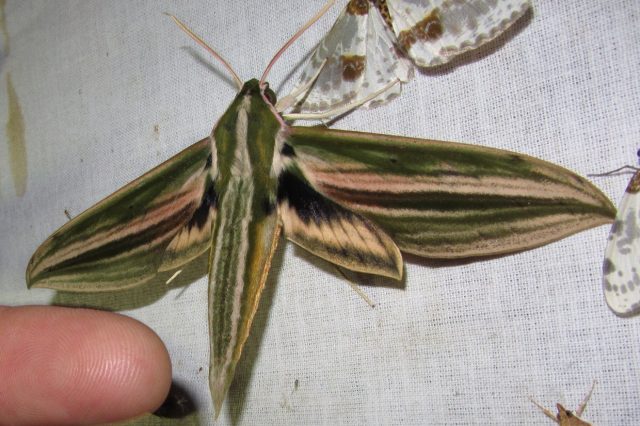
Hawk moths may be jamming bat sonar signals by rubbing their genitals.
The behavior, reported in Biology Letters on 3 July, creates an ultrasonic noise that could be used to scare off an attacking bat by jamming the bat's sonar.
Radar jamming is a common tool in human warfare, clearing the way for aircraft to bomb enemy targets without detection. By flooding the radar frequency with noise, an attacker can render radar useless. A radar operator can resist by switching frequencies randomly, but modern attack techniques, reported to have been used by Israel during a 2007 attack on Syria, bypass traditional "jamming" altogether and straight-up hacks the enemy radar.
A similar arms race has been going on in the natural world between bats, which rely on ultrasonic echolocation—or sonar—to "see," and some species of moths, which have developed special bat-detecting ears and, as this latest study shows, other techniques to counter a bat's sonar.
Researchers at Boise State University and the Florida Museum of Natural History imitated a big brown bat and eastern red bat attack and recorded the responses of male and female hawk moths.
The imitated attack was created by playing the bats' sonar attack sequence, which they had pre-recorded by hanging a worm next to an ultrasonic microphone as they swooped in for the kill. An artificial bat attack sound was also used.
When the hawk moths heard the attack sounds, they created an ultrasonic response by rubbing their genitals against their abdomens, though male and female moths did so using slightly different mechanisms. They also created the sound when touched. Three species of hawk moth, Cechenena lineosa, Theretra boisduvalii, and Theretra nessus, displayed the behavior.
Tiger moths were previously the only moth thought to be able to use a bat's sonar against them. They have been shown to use their anti-bat sonar to startle bats, to "jam" the bats' signals, and to warn the bats not to mess with them—in essence, they've learned the bats' language in order to warn them off. Only one other insect, the tiger beetle, has been shown to respond acoustically to bat sonar.
"The […] anti-bat ultrasound production in hawkmoths […] might play a similar role as in tiger moths—to startle, warn of chemical defense, or jam biosonar," write authors Jesse Barber and Akito Kawahara.
The hawk moth research didn't specifically look at the effect of such signals on bats, so it's not yet known how the bats respond.
Intriguingly, the research shows that the moths only responded near the end of the bat attack sequence, suggesting that it is a final line of defense, perhaps a last minute "pocket sand" attack.
You can view the original story as it appeared on Wired.co.uk here.
reader comments
35